Applying Modern Portfolio Theory: Investment Strategies and Analysis
VerifiedAdded on 2023/06/11
|13
|3858
|271
Report
AI Summary
This report provides a comprehensive analysis of investment strategies using Modern Portfolio Theory, covering topics such as factors affecting risk tolerance, problems with portfolio allocation, return requirements for retirement, and investment constraints. It includes calculations for forward rates on T-bills, Macaulay duration, and percentage changes in bond prices, along with an industry analysis and computation of a company's intrinsic value for investment advice. The report uses the case of Maggie to discuss investment portfolio management or wealth management. The modern portfolio theory is an emerging concept in the field of investment suggesting a way for investment selection, so that overall returns could be maximized at a level of risk acceptable to investor. The basic idea of modern portfolio theory is to diversify portfolio among different investment options having risk and return either high or low.
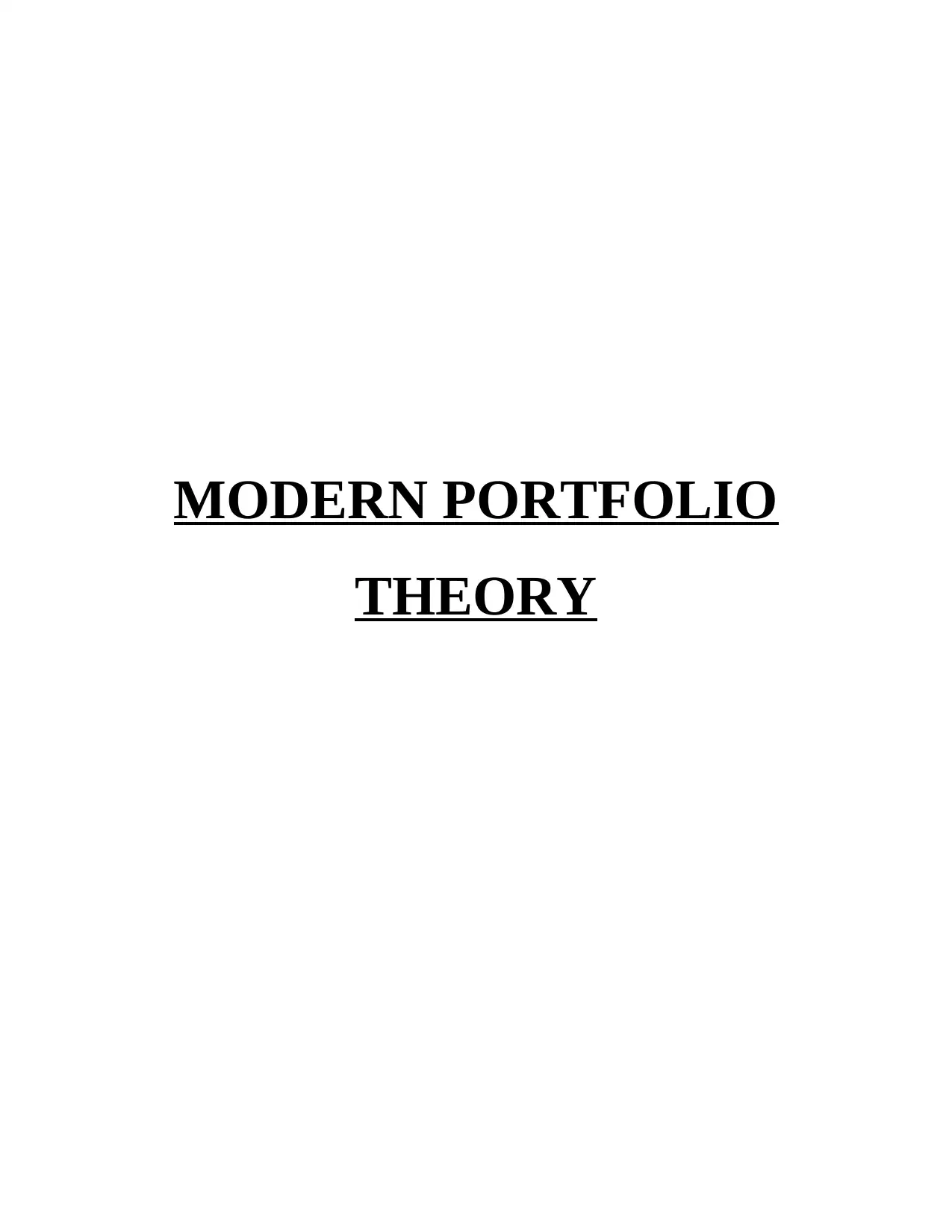
MODERN PORTFOLIO
THEORY
THEORY
Paraphrase This Document
Need a fresh take? Get an instant paraphrase of this document with our AI Paraphraser
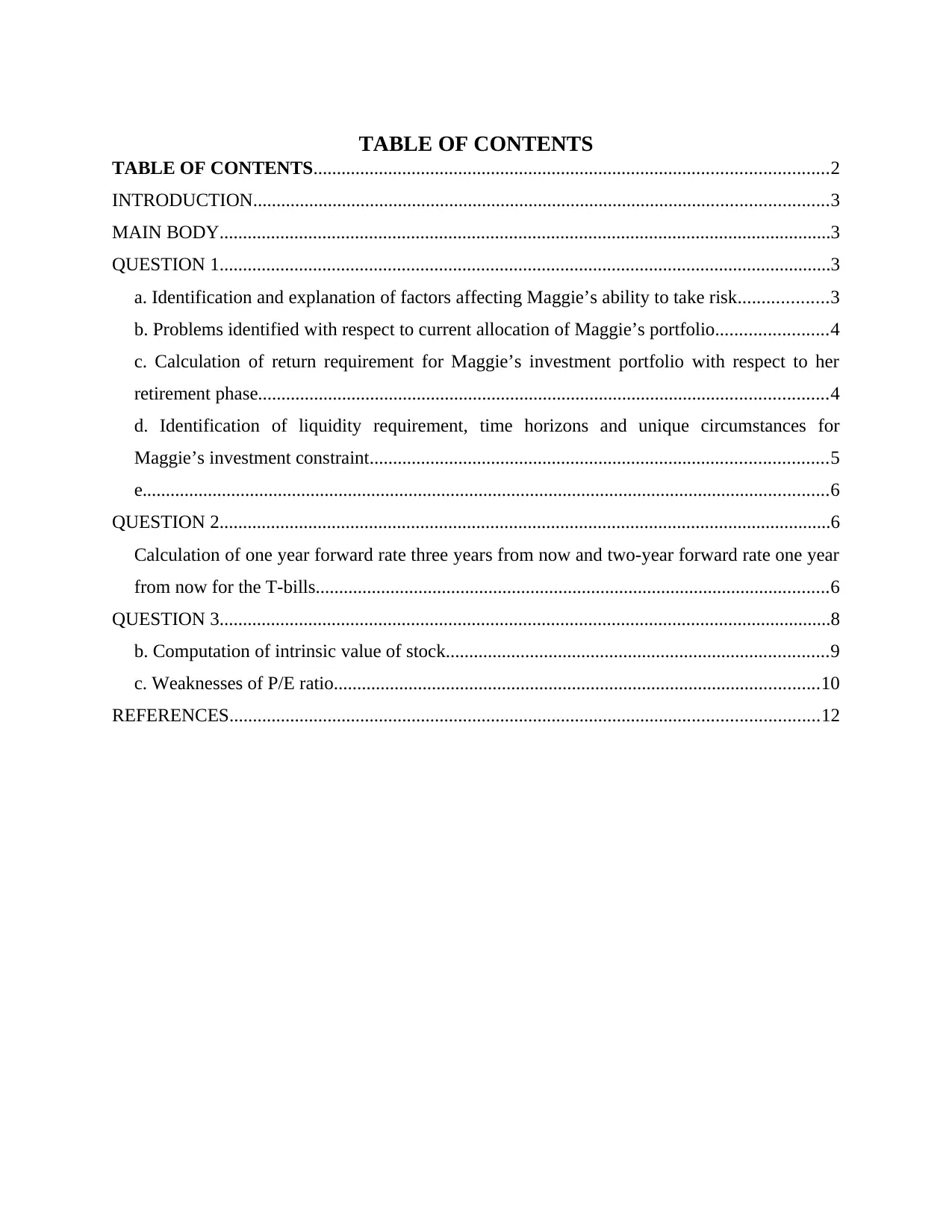
TABLE OF CONTENTS
TABLE OF CONTENTS..............................................................................................................2
INTRODUCTION...........................................................................................................................3
MAIN BODY...................................................................................................................................3
QUESTION 1...................................................................................................................................3
a. Identification and explanation of factors affecting Maggie’s ability to take risk...................3
b. Problems identified with respect to current allocation of Maggie’s portfolio........................4
c. Calculation of return requirement for Maggie’s investment portfolio with respect to her
retirement phase..........................................................................................................................4
d. Identification of liquidity requirement, time horizons and unique circumstances for
Maggie’s investment constraint..................................................................................................5
e...................................................................................................................................................6
QUESTION 2...................................................................................................................................6
Calculation of one year forward rate three years from now and two-year forward rate one year
from now for the T-bills..............................................................................................................6
QUESTION 3...................................................................................................................................8
b. Computation of intrinsic value of stock..................................................................................9
c. Weaknesses of P/E ratio........................................................................................................10
REFERENCES..............................................................................................................................12
TABLE OF CONTENTS..............................................................................................................2
INTRODUCTION...........................................................................................................................3
MAIN BODY...................................................................................................................................3
QUESTION 1...................................................................................................................................3
a. Identification and explanation of factors affecting Maggie’s ability to take risk...................3
b. Problems identified with respect to current allocation of Maggie’s portfolio........................4
c. Calculation of return requirement for Maggie’s investment portfolio with respect to her
retirement phase..........................................................................................................................4
d. Identification of liquidity requirement, time horizons and unique circumstances for
Maggie’s investment constraint..................................................................................................5
e...................................................................................................................................................6
QUESTION 2...................................................................................................................................6
Calculation of one year forward rate three years from now and two-year forward rate one year
from now for the T-bills..............................................................................................................6
QUESTION 3...................................................................................................................................8
b. Computation of intrinsic value of stock..................................................................................9
c. Weaknesses of P/E ratio........................................................................................................10
REFERENCES..............................................................................................................................12
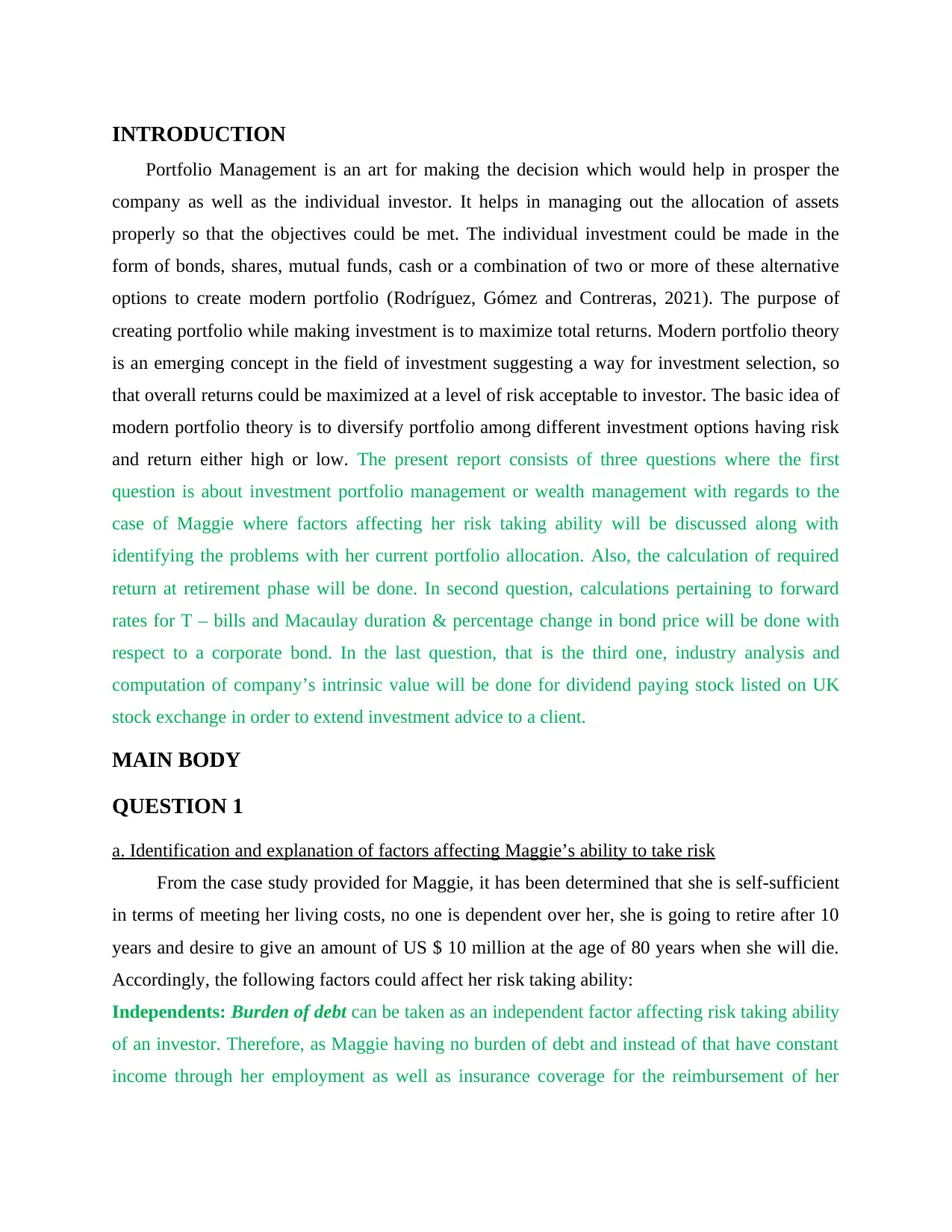
INTRODUCTION
Portfolio Management is an art for making the decision which would help in prosper the
company as well as the individual investor. It helps in managing out the allocation of assets
properly so that the objectives could be met. The individual investment could be made in the
form of bonds, shares, mutual funds, cash or a combination of two or more of these alternative
options to create modern portfolio (Rodríguez, Gómez and Contreras, 2021). The purpose of
creating portfolio while making investment is to maximize total returns. Modern portfolio theory
is an emerging concept in the field of investment suggesting a way for investment selection, so
that overall returns could be maximized at a level of risk acceptable to investor. The basic idea of
modern portfolio theory is to diversify portfolio among different investment options having risk
and return either high or low. The present report consists of three questions where the first
question is about investment portfolio management or wealth management with regards to the
case of Maggie where factors affecting her risk taking ability will be discussed along with
identifying the problems with her current portfolio allocation. Also, the calculation of required
return at retirement phase will be done. In second question, calculations pertaining to forward
rates for T – bills and Macaulay duration & percentage change in bond price will be done with
respect to a corporate bond. In the last question, that is the third one, industry analysis and
computation of company’s intrinsic value will be done for dividend paying stock listed on UK
stock exchange in order to extend investment advice to a client.
MAIN BODY
QUESTION 1
a. Identification and explanation of factors affecting Maggie’s ability to take risk
From the case study provided for Maggie, it has been determined that she is self-sufficient
in terms of meeting her living costs, no one is dependent over her, she is going to retire after 10
years and desire to give an amount of US $ 10 million at the age of 80 years when she will die.
Accordingly, the following factors could affect her risk taking ability:
Independents: Burden of debt can be taken as an independent factor affecting risk taking ability
of an investor. Therefore, as Maggie having no burden of debt and instead of that have constant
income through her employment as well as insurance coverage for the reimbursement of her
Portfolio Management is an art for making the decision which would help in prosper the
company as well as the individual investor. It helps in managing out the allocation of assets
properly so that the objectives could be met. The individual investment could be made in the
form of bonds, shares, mutual funds, cash or a combination of two or more of these alternative
options to create modern portfolio (Rodríguez, Gómez and Contreras, 2021). The purpose of
creating portfolio while making investment is to maximize total returns. Modern portfolio theory
is an emerging concept in the field of investment suggesting a way for investment selection, so
that overall returns could be maximized at a level of risk acceptable to investor. The basic idea of
modern portfolio theory is to diversify portfolio among different investment options having risk
and return either high or low. The present report consists of three questions where the first
question is about investment portfolio management or wealth management with regards to the
case of Maggie where factors affecting her risk taking ability will be discussed along with
identifying the problems with her current portfolio allocation. Also, the calculation of required
return at retirement phase will be done. In second question, calculations pertaining to forward
rates for T – bills and Macaulay duration & percentage change in bond price will be done with
respect to a corporate bond. In the last question, that is the third one, industry analysis and
computation of company’s intrinsic value will be done for dividend paying stock listed on UK
stock exchange in order to extend investment advice to a client.
MAIN BODY
QUESTION 1
a. Identification and explanation of factors affecting Maggie’s ability to take risk
From the case study provided for Maggie, it has been determined that she is self-sufficient
in terms of meeting her living costs, no one is dependent over her, she is going to retire after 10
years and desire to give an amount of US $ 10 million at the age of 80 years when she will die.
Accordingly, the following factors could affect her risk taking ability:
Independents: Burden of debt can be taken as an independent factor affecting risk taking ability
of an investor. Therefore, as Maggie having no burden of debt and instead of that have constant
income through her employment as well as insurance coverage for the reimbursement of her
⊘ This is a preview!⊘
Do you want full access?
Subscribe today to unlock all pages.

Trusted by 1+ million students worldwide
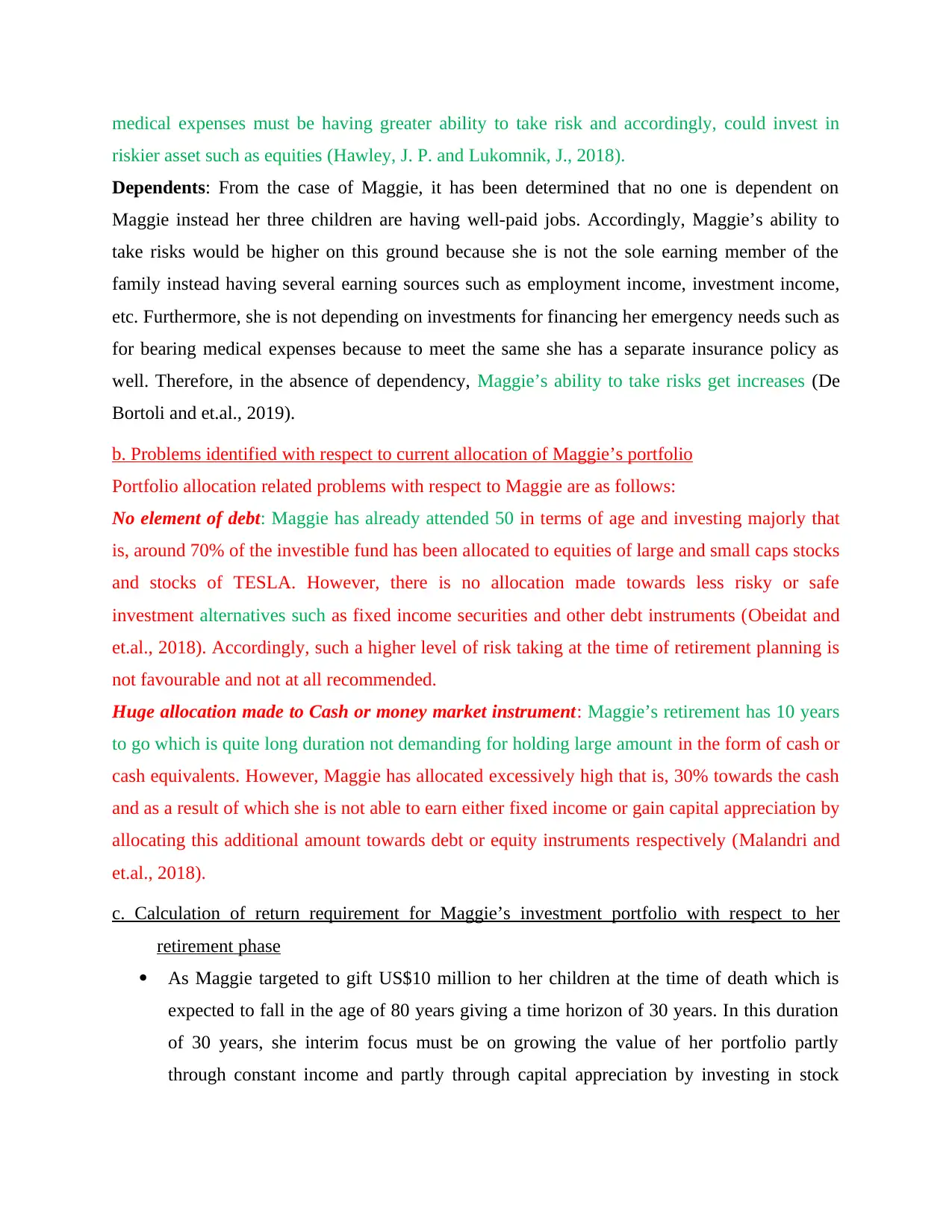
medical expenses must be having greater ability to take risk and accordingly, could invest in
riskier asset such as equities (Hawley, J. P. and Lukomnik, J., 2018).
Dependents: From the case of Maggie, it has been determined that no one is dependent on
Maggie instead her three children are having well-paid jobs. Accordingly, Maggie’s ability to
take risks would be higher on this ground because she is not the sole earning member of the
family instead having several earning sources such as employment income, investment income,
etc. Furthermore, she is not depending on investments for financing her emergency needs such as
for bearing medical expenses because to meet the same she has a separate insurance policy as
well. Therefore, in the absence of dependency, Maggie’s ability to take risks get increases (De
Bortoli and et.al., 2019).
b. Problems identified with respect to current allocation of Maggie’s portfolio
Portfolio allocation related problems with respect to Maggie are as follows:
No element of debt: Maggie has already attended 50 in terms of age and investing majorly that
is, around 70% of the investible fund has been allocated to equities of large and small caps stocks
and stocks of TESLA. However, there is no allocation made towards less risky or safe
investment alternatives such as fixed income securities and other debt instruments (Obeidat and
et.al., 2018). Accordingly, such a higher level of risk taking at the time of retirement planning is
not favourable and not at all recommended.
Huge allocation made to Cash or money market instrument: Maggie’s retirement has 10 years
to go which is quite long duration not demanding for holding large amount in the form of cash or
cash equivalents. However, Maggie has allocated excessively high that is, 30% towards the cash
and as a result of which she is not able to earn either fixed income or gain capital appreciation by
allocating this additional amount towards debt or equity instruments respectively (Malandri and
et.al., 2018).
c. Calculation of return requirement for Maggie’s investment portfolio with respect to her
retirement phase
As Maggie targeted to gift US$10 million to her children at the time of death which is
expected to fall in the age of 80 years giving a time horizon of 30 years. In this duration
of 30 years, she interim focus must be on growing the value of her portfolio partly
through constant income and partly through capital appreciation by investing in stock
riskier asset such as equities (Hawley, J. P. and Lukomnik, J., 2018).
Dependents: From the case of Maggie, it has been determined that no one is dependent on
Maggie instead her three children are having well-paid jobs. Accordingly, Maggie’s ability to
take risks would be higher on this ground because she is not the sole earning member of the
family instead having several earning sources such as employment income, investment income,
etc. Furthermore, she is not depending on investments for financing her emergency needs such as
for bearing medical expenses because to meet the same she has a separate insurance policy as
well. Therefore, in the absence of dependency, Maggie’s ability to take risks get increases (De
Bortoli and et.al., 2019).
b. Problems identified with respect to current allocation of Maggie’s portfolio
Portfolio allocation related problems with respect to Maggie are as follows:
No element of debt: Maggie has already attended 50 in terms of age and investing majorly that
is, around 70% of the investible fund has been allocated to equities of large and small caps stocks
and stocks of TESLA. However, there is no allocation made towards less risky or safe
investment alternatives such as fixed income securities and other debt instruments (Obeidat and
et.al., 2018). Accordingly, such a higher level of risk taking at the time of retirement planning is
not favourable and not at all recommended.
Huge allocation made to Cash or money market instrument: Maggie’s retirement has 10 years
to go which is quite long duration not demanding for holding large amount in the form of cash or
cash equivalents. However, Maggie has allocated excessively high that is, 30% towards the cash
and as a result of which she is not able to earn either fixed income or gain capital appreciation by
allocating this additional amount towards debt or equity instruments respectively (Malandri and
et.al., 2018).
c. Calculation of return requirement for Maggie’s investment portfolio with respect to her
retirement phase
As Maggie targeted to gift US$10 million to her children at the time of death which is
expected to fall in the age of 80 years giving a time horizon of 30 years. In this duration
of 30 years, she interim focus must be on growing the value of her portfolio partly
through constant income and partly through capital appreciation by investing in stock
Paraphrase This Document
Need a fresh take? Get an instant paraphrase of this document with our AI Paraphraser
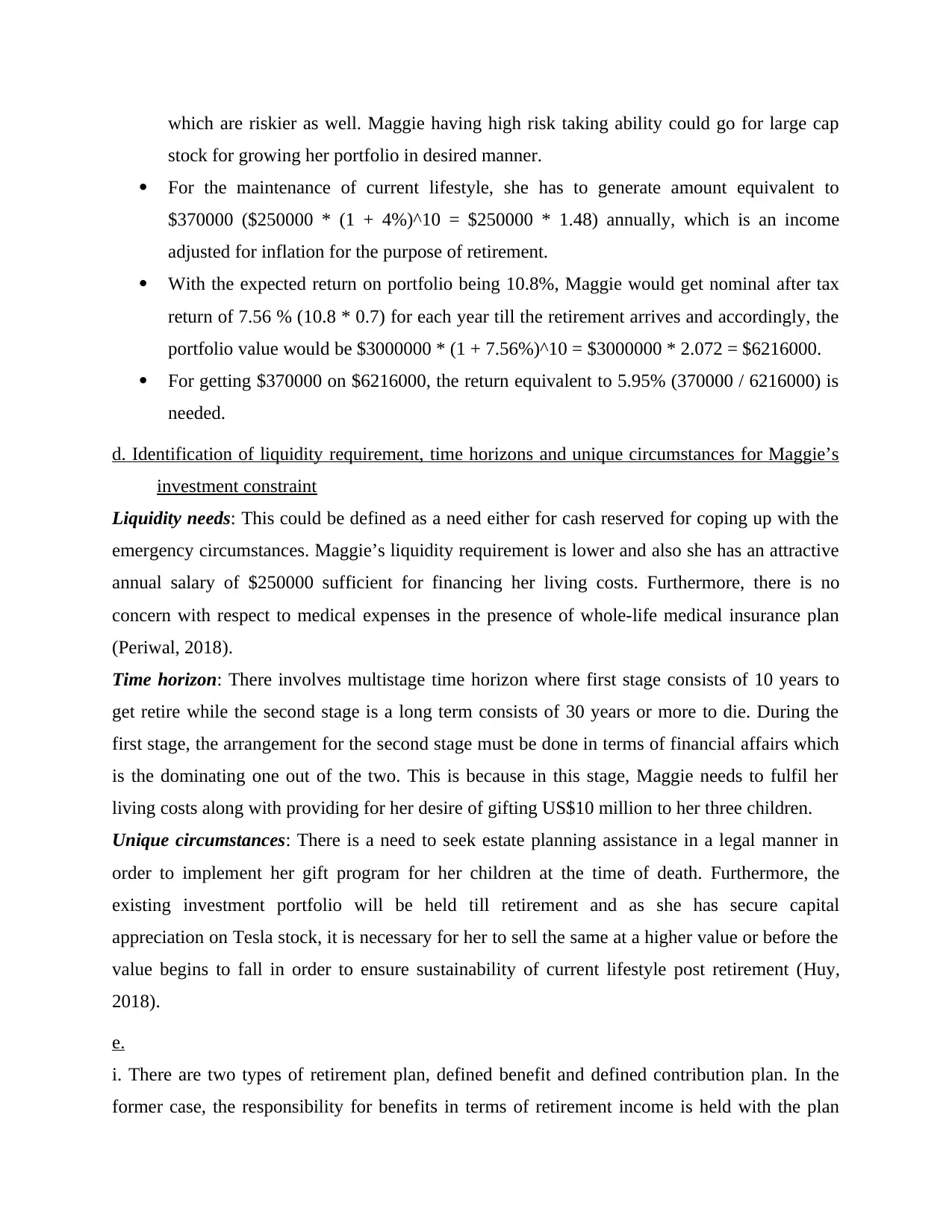
which are riskier as well. Maggie having high risk taking ability could go for large cap
stock for growing her portfolio in desired manner.
For the maintenance of current lifestyle, she has to generate amount equivalent to
$370000 ($250000 * (1 + 4%)^10 = $250000 * 1.48) annually, which is an income
adjusted for inflation for the purpose of retirement.
With the expected return on portfolio being 10.8%, Maggie would get nominal after tax
return of 7.56 % (10.8 * 0.7) for each year till the retirement arrives and accordingly, the
portfolio value would be $3000000 * (1 + 7.56%)^10 = $3000000 * 2.072 = $6216000.
For getting $370000 on $6216000, the return equivalent to 5.95% (370000 / 6216000) is
needed.
d. Identification of liquidity requirement, time horizons and unique circumstances for Maggie’s
investment constraint
Liquidity needs: This could be defined as a need either for cash reserved for coping up with the
emergency circumstances. Maggie’s liquidity requirement is lower and also she has an attractive
annual salary of $250000 sufficient for financing her living costs. Furthermore, there is no
concern with respect to medical expenses in the presence of whole-life medical insurance plan
(Periwal, 2018).
Time horizon: There involves multistage time horizon where first stage consists of 10 years to
get retire while the second stage is a long term consists of 30 years or more to die. During the
first stage, the arrangement for the second stage must be done in terms of financial affairs which
is the dominating one out of the two. This is because in this stage, Maggie needs to fulfil her
living costs along with providing for her desire of gifting US$10 million to her three children.
Unique circumstances: There is a need to seek estate planning assistance in a legal manner in
order to implement her gift program for her children at the time of death. Furthermore, the
existing investment portfolio will be held till retirement and as she has secure capital
appreciation on Tesla stock, it is necessary for her to sell the same at a higher value or before the
value begins to fall in order to ensure sustainability of current lifestyle post retirement (Huy,
2018).
e.
i. There are two types of retirement plan, defined benefit and defined contribution plan. In the
former case, the responsibility for benefits in terms of retirement income is held with the plan
stock for growing her portfolio in desired manner.
For the maintenance of current lifestyle, she has to generate amount equivalent to
$370000 ($250000 * (1 + 4%)^10 = $250000 * 1.48) annually, which is an income
adjusted for inflation for the purpose of retirement.
With the expected return on portfolio being 10.8%, Maggie would get nominal after tax
return of 7.56 % (10.8 * 0.7) for each year till the retirement arrives and accordingly, the
portfolio value would be $3000000 * (1 + 7.56%)^10 = $3000000 * 2.072 = $6216000.
For getting $370000 on $6216000, the return equivalent to 5.95% (370000 / 6216000) is
needed.
d. Identification of liquidity requirement, time horizons and unique circumstances for Maggie’s
investment constraint
Liquidity needs: This could be defined as a need either for cash reserved for coping up with the
emergency circumstances. Maggie’s liquidity requirement is lower and also she has an attractive
annual salary of $250000 sufficient for financing her living costs. Furthermore, there is no
concern with respect to medical expenses in the presence of whole-life medical insurance plan
(Periwal, 2018).
Time horizon: There involves multistage time horizon where first stage consists of 10 years to
get retire while the second stage is a long term consists of 30 years or more to die. During the
first stage, the arrangement for the second stage must be done in terms of financial affairs which
is the dominating one out of the two. This is because in this stage, Maggie needs to fulfil her
living costs along with providing for her desire of gifting US$10 million to her three children.
Unique circumstances: There is a need to seek estate planning assistance in a legal manner in
order to implement her gift program for her children at the time of death. Furthermore, the
existing investment portfolio will be held till retirement and as she has secure capital
appreciation on Tesla stock, it is necessary for her to sell the same at a higher value or before the
value begins to fall in order to ensure sustainability of current lifestyle post retirement (Huy,
2018).
e.
i. There are two types of retirement plan, defined benefit and defined contribution plan. In the
former case, the responsibility for benefits in terms of retirement income is held with the plan

sponsor and is inflation adjusted while in the latter case, plan sponsor is responsible for a fixed %
contribution out of the salary of plan participant who is thus responsible for the benefits
accordingly.
In case of DB plan, sponsor bears all the risk while in case of DC plan, participants bear all the
risks and thus provides for greater probability of benefit as compared to DB plan.
Hugo in her young age is capable of taking greater risk and could set his own objectives
pertaining to risk and return. Therefore, DC plan is suitable for Hugo which is having greater
probability of benefits as well.
ii. Two characteristics of Defined Contribution plan
Plan participants has the duty to set the constraints and objectives with respect to risk and
return (Singh and Yadav, 2021).
With the several investment options offered by sponsor, participant could choose most
suitable options on the basis of their risk/return objectives and constraints. However, the
latter remains responsible for benefits from the plan in future.
QUESTION 2
Calculation of one year forward rate three years from now and two-year forward rate one year
from now for the T-bills
One year forward rate three years from now has been calculate with the help of following
formula:
(((1 + Spot rate for time period 1) ^ Time period 1) / ((1 + Spot rate for time period 2) ^ Time
period 2)) ^ (1 / (Time period 1 - Time period 2)) – 1
Spot rate for time period 1 = Spot rate in year 4 = 6.2%
Time period 1 = year 4
Spot rate for time period 2 = Spot rate in year 3 = 6%
Time period 2 = year 3
Accordingly,
(((1 + 0.062) ^ 4) / ((1 + 0.06) ^ 3)) ^ (1 / (4 - 3)) – 1
= (1.2720 / 1.2624) ^1 – 1
= 1.0076 – 1 = 0.0076 = 0.76%
contribution out of the salary of plan participant who is thus responsible for the benefits
accordingly.
In case of DB plan, sponsor bears all the risk while in case of DC plan, participants bear all the
risks and thus provides for greater probability of benefit as compared to DB plan.
Hugo in her young age is capable of taking greater risk and could set his own objectives
pertaining to risk and return. Therefore, DC plan is suitable for Hugo which is having greater
probability of benefits as well.
ii. Two characteristics of Defined Contribution plan
Plan participants has the duty to set the constraints and objectives with respect to risk and
return (Singh and Yadav, 2021).
With the several investment options offered by sponsor, participant could choose most
suitable options on the basis of their risk/return objectives and constraints. However, the
latter remains responsible for benefits from the plan in future.
QUESTION 2
Calculation of one year forward rate three years from now and two-year forward rate one year
from now for the T-bills
One year forward rate three years from now has been calculate with the help of following
formula:
(((1 + Spot rate for time period 1) ^ Time period 1) / ((1 + Spot rate for time period 2) ^ Time
period 2)) ^ (1 / (Time period 1 - Time period 2)) – 1
Spot rate for time period 1 = Spot rate in year 4 = 6.2%
Time period 1 = year 4
Spot rate for time period 2 = Spot rate in year 3 = 6%
Time period 2 = year 3
Accordingly,
(((1 + 0.062) ^ 4) / ((1 + 0.06) ^ 3)) ^ (1 / (4 - 3)) – 1
= (1.2720 / 1.2624) ^1 – 1
= 1.0076 – 1 = 0.0076 = 0.76%
⊘ This is a preview!⊘
Do you want full access?
Subscribe today to unlock all pages.

Trusted by 1+ million students worldwide
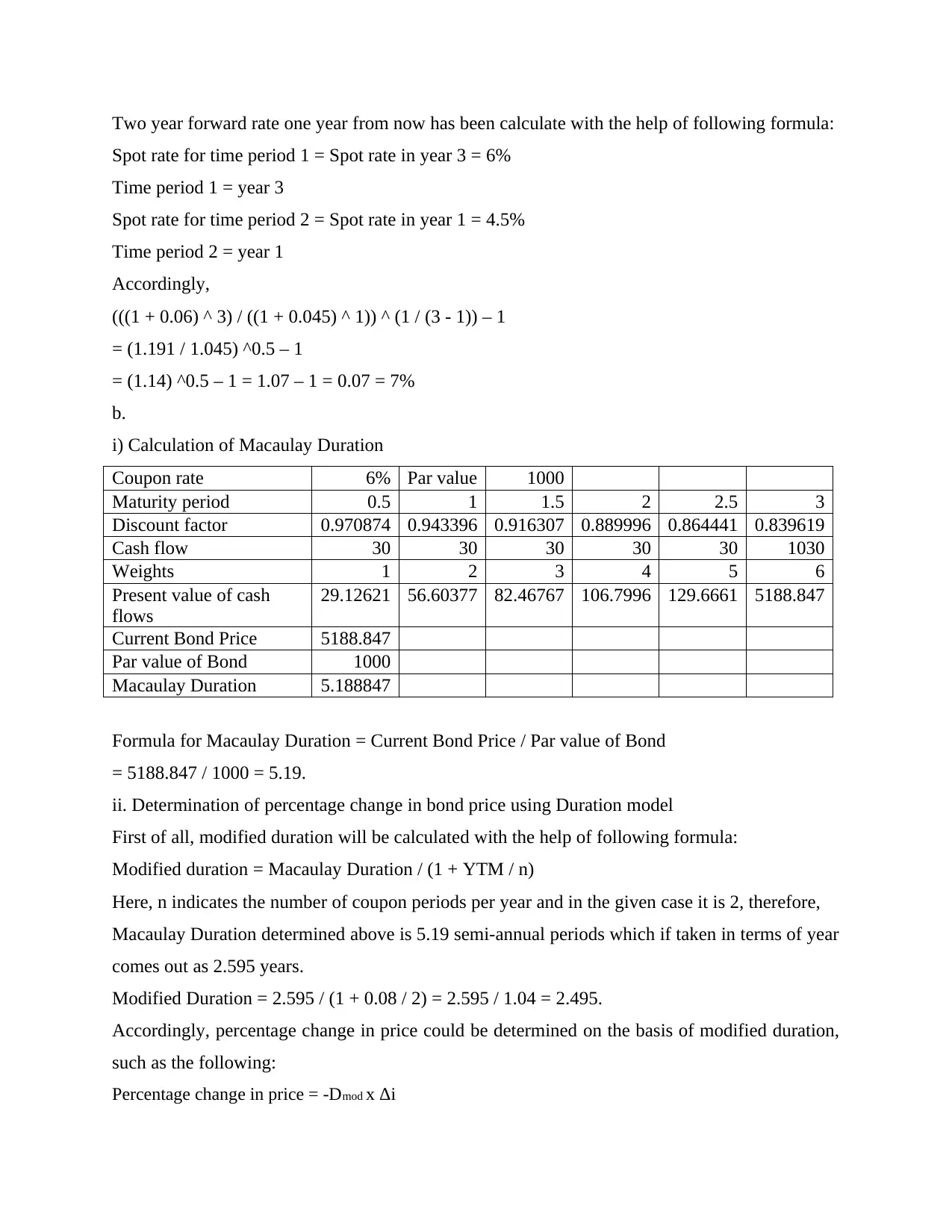
Two year forward rate one year from now has been calculate with the help of following formula:
Spot rate for time period 1 = Spot rate in year 3 = 6%
Time period 1 = year 3
Spot rate for time period 2 = Spot rate in year 1 = 4.5%
Time period 2 = year 1
Accordingly,
(((1 + 0.06) ^ 3) / ((1 + 0.045) ^ 1)) ^ (1 / (3 - 1)) – 1
= (1.191 / 1.045) ^0.5 – 1
= (1.14) ^0.5 – 1 = 1.07 – 1 = 0.07 = 7%
b.
i) Calculation of Macaulay Duration
Coupon rate 6% Par value 1000
Maturity period 0.5 1 1.5 2 2.5 3
Discount factor 0.970874 0.943396 0.916307 0.889996 0.864441 0.839619
Cash flow 30 30 30 30 30 1030
Weights 1 2 3 4 5 6
Present value of cash
flows
29.12621 56.60377 82.46767 106.7996 129.6661 5188.847
Current Bond Price 5188.847
Par value of Bond 1000
Macaulay Duration 5.188847
Formula for Macaulay Duration = Current Bond Price / Par value of Bond
= 5188.847 / 1000 = 5.19.
ii. Determination of percentage change in bond price using Duration model
First of all, modified duration will be calculated with the help of following formula:
Modified duration = Macaulay Duration / (1 + YTM / n)
Here, n indicates the number of coupon periods per year and in the given case it is 2, therefore,
Macaulay Duration determined above is 5.19 semi-annual periods which if taken in terms of year
comes out as 2.595 years.
Modified Duration = 2.595 / (1 + 0.08 / 2) = 2.595 / 1.04 = 2.495.
Accordingly, percentage change in price could be determined on the basis of modified duration,
such as the following:
Percentage change in price = -Dmod x Δi
Spot rate for time period 1 = Spot rate in year 3 = 6%
Time period 1 = year 3
Spot rate for time period 2 = Spot rate in year 1 = 4.5%
Time period 2 = year 1
Accordingly,
(((1 + 0.06) ^ 3) / ((1 + 0.045) ^ 1)) ^ (1 / (3 - 1)) – 1
= (1.191 / 1.045) ^0.5 – 1
= (1.14) ^0.5 – 1 = 1.07 – 1 = 0.07 = 7%
b.
i) Calculation of Macaulay Duration
Coupon rate 6% Par value 1000
Maturity period 0.5 1 1.5 2 2.5 3
Discount factor 0.970874 0.943396 0.916307 0.889996 0.864441 0.839619
Cash flow 30 30 30 30 30 1030
Weights 1 2 3 4 5 6
Present value of cash
flows
29.12621 56.60377 82.46767 106.7996 129.6661 5188.847
Current Bond Price 5188.847
Par value of Bond 1000
Macaulay Duration 5.188847
Formula for Macaulay Duration = Current Bond Price / Par value of Bond
= 5188.847 / 1000 = 5.19.
ii. Determination of percentage change in bond price using Duration model
First of all, modified duration will be calculated with the help of following formula:
Modified duration = Macaulay Duration / (1 + YTM / n)
Here, n indicates the number of coupon periods per year and in the given case it is 2, therefore,
Macaulay Duration determined above is 5.19 semi-annual periods which if taken in terms of year
comes out as 2.595 years.
Modified Duration = 2.595 / (1 + 0.08 / 2) = 2.595 / 1.04 = 2.495.
Accordingly, percentage change in price could be determined on the basis of modified duration,
such as the following:
Percentage change in price = -Dmod x Δi
Paraphrase This Document
Need a fresh take? Get an instant paraphrase of this document with our AI Paraphraser
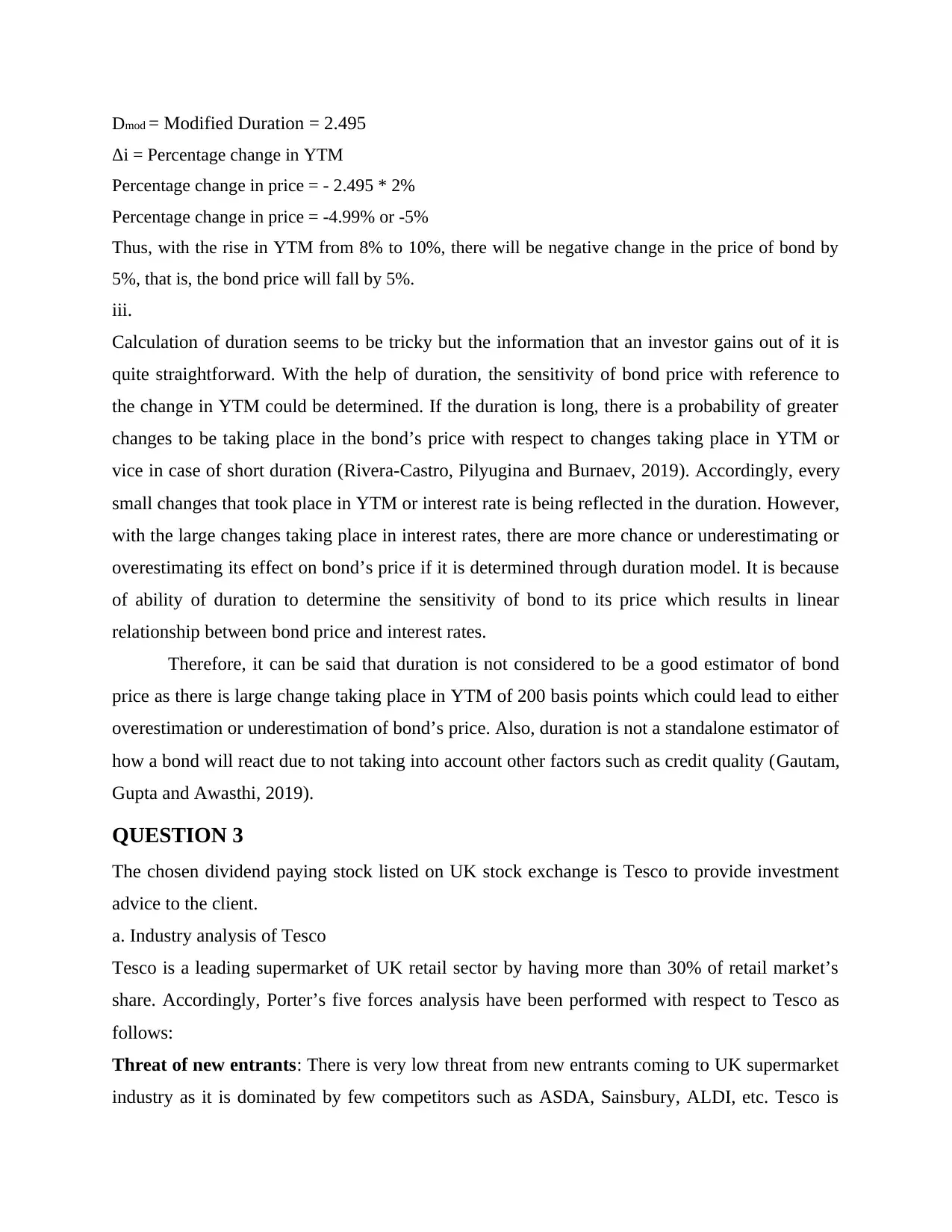
Dmod = Modified Duration = 2.495
Δi = Percentage change in YTM
Percentage change in price = - 2.495 * 2%
Percentage change in price = -4.99% or -5%
Thus, with the rise in YTM from 8% to 10%, there will be negative change in the price of bond by
5%, that is, the bond price will fall by 5%.
iii.
Calculation of duration seems to be tricky but the information that an investor gains out of it is
quite straightforward. With the help of duration, the sensitivity of bond price with reference to
the change in YTM could be determined. If the duration is long, there is a probability of greater
changes to be taking place in the bond’s price with respect to changes taking place in YTM or
vice in case of short duration (Rivera-Castro, Pilyugina and Burnaev, 2019). Accordingly, every
small changes that took place in YTM or interest rate is being reflected in the duration. However,
with the large changes taking place in interest rates, there are more chance or underestimating or
overestimating its effect on bond’s price if it is determined through duration model. It is because
of ability of duration to determine the sensitivity of bond to its price which results in linear
relationship between bond price and interest rates.
Therefore, it can be said that duration is not considered to be a good estimator of bond
price as there is large change taking place in YTM of 200 basis points which could lead to either
overestimation or underestimation of bond’s price. Also, duration is not a standalone estimator of
how a bond will react due to not taking into account other factors such as credit quality (Gautam,
Gupta and Awasthi, 2019).
QUESTION 3
The chosen dividend paying stock listed on UK stock exchange is Tesco to provide investment
advice to the client.
a. Industry analysis of Tesco
Tesco is a leading supermarket of UK retail sector by having more than 30% of retail market’s
share. Accordingly, Porter’s five forces analysis have been performed with respect to Tesco as
follows:
Threat of new entrants: There is very low threat from new entrants coming to UK supermarket
industry as it is dominated by few competitors such as ASDA, Sainsbury, ALDI, etc. Tesco is
Δi = Percentage change in YTM
Percentage change in price = - 2.495 * 2%
Percentage change in price = -4.99% or -5%
Thus, with the rise in YTM from 8% to 10%, there will be negative change in the price of bond by
5%, that is, the bond price will fall by 5%.
iii.
Calculation of duration seems to be tricky but the information that an investor gains out of it is
quite straightforward. With the help of duration, the sensitivity of bond price with reference to
the change in YTM could be determined. If the duration is long, there is a probability of greater
changes to be taking place in the bond’s price with respect to changes taking place in YTM or
vice in case of short duration (Rivera-Castro, Pilyugina and Burnaev, 2019). Accordingly, every
small changes that took place in YTM or interest rate is being reflected in the duration. However,
with the large changes taking place in interest rates, there are more chance or underestimating or
overestimating its effect on bond’s price if it is determined through duration model. It is because
of ability of duration to determine the sensitivity of bond to its price which results in linear
relationship between bond price and interest rates.
Therefore, it can be said that duration is not considered to be a good estimator of bond
price as there is large change taking place in YTM of 200 basis points which could lead to either
overestimation or underestimation of bond’s price. Also, duration is not a standalone estimator of
how a bond will react due to not taking into account other factors such as credit quality (Gautam,
Gupta and Awasthi, 2019).
QUESTION 3
The chosen dividend paying stock listed on UK stock exchange is Tesco to provide investment
advice to the client.
a. Industry analysis of Tesco
Tesco is a leading supermarket of UK retail sector by having more than 30% of retail market’s
share. Accordingly, Porter’s five forces analysis have been performed with respect to Tesco as
follows:
Threat of new entrants: There is very low threat from new entrants coming to UK supermarket
industry as it is dominated by few competitors such as ASDA, Sainsbury, ALDI, etc. Tesco is
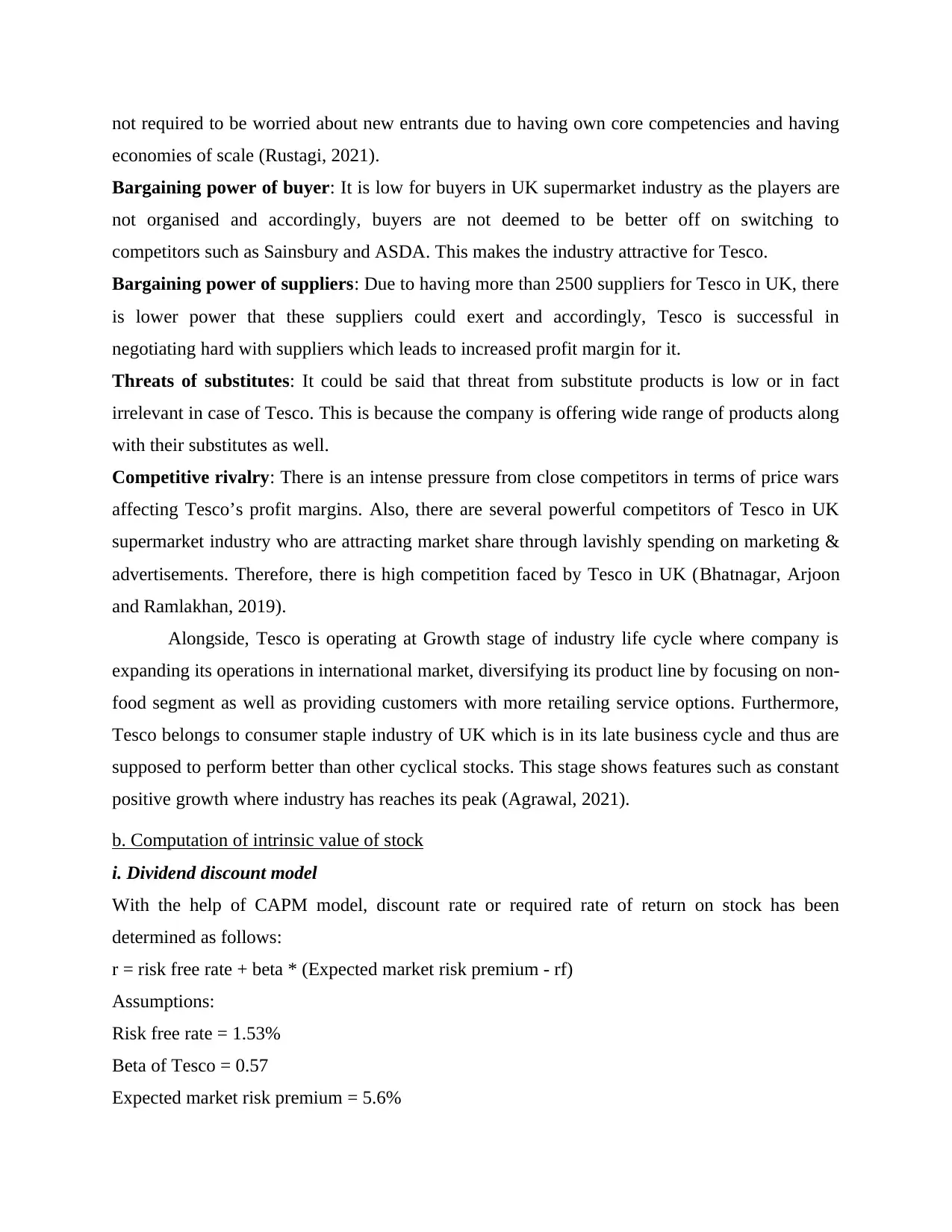
not required to be worried about new entrants due to having own core competencies and having
economies of scale (Rustagi, 2021).
Bargaining power of buyer: It is low for buyers in UK supermarket industry as the players are
not organised and accordingly, buyers are not deemed to be better off on switching to
competitors such as Sainsbury and ASDA. This makes the industry attractive for Tesco.
Bargaining power of suppliers: Due to having more than 2500 suppliers for Tesco in UK, there
is lower power that these suppliers could exert and accordingly, Tesco is successful in
negotiating hard with suppliers which leads to increased profit margin for it.
Threats of substitutes: It could be said that threat from substitute products is low or in fact
irrelevant in case of Tesco. This is because the company is offering wide range of products along
with their substitutes as well.
Competitive rivalry: There is an intense pressure from close competitors in terms of price wars
affecting Tesco’s profit margins. Also, there are several powerful competitors of Tesco in UK
supermarket industry who are attracting market share through lavishly spending on marketing &
advertisements. Therefore, there is high competition faced by Tesco in UK (Bhatnagar, Arjoon
and Ramlakhan, 2019).
Alongside, Tesco is operating at Growth stage of industry life cycle where company is
expanding its operations in international market, diversifying its product line by focusing on non-
food segment as well as providing customers with more retailing service options. Furthermore,
Tesco belongs to consumer staple industry of UK which is in its late business cycle and thus are
supposed to perform better than other cyclical stocks. This stage shows features such as constant
positive growth where industry has reaches its peak (Agrawal, 2021).
b. Computation of intrinsic value of stock
i. Dividend discount model
With the help of CAPM model, discount rate or required rate of return on stock has been
determined as follows:
r = risk free rate + beta * (Expected market risk premium - rf)
Assumptions:
Risk free rate = 1.53%
Beta of Tesco = 0.57
Expected market risk premium = 5.6%
economies of scale (Rustagi, 2021).
Bargaining power of buyer: It is low for buyers in UK supermarket industry as the players are
not organised and accordingly, buyers are not deemed to be better off on switching to
competitors such as Sainsbury and ASDA. This makes the industry attractive for Tesco.
Bargaining power of suppliers: Due to having more than 2500 suppliers for Tesco in UK, there
is lower power that these suppliers could exert and accordingly, Tesco is successful in
negotiating hard with suppliers which leads to increased profit margin for it.
Threats of substitutes: It could be said that threat from substitute products is low or in fact
irrelevant in case of Tesco. This is because the company is offering wide range of products along
with their substitutes as well.
Competitive rivalry: There is an intense pressure from close competitors in terms of price wars
affecting Tesco’s profit margins. Also, there are several powerful competitors of Tesco in UK
supermarket industry who are attracting market share through lavishly spending on marketing &
advertisements. Therefore, there is high competition faced by Tesco in UK (Bhatnagar, Arjoon
and Ramlakhan, 2019).
Alongside, Tesco is operating at Growth stage of industry life cycle where company is
expanding its operations in international market, diversifying its product line by focusing on non-
food segment as well as providing customers with more retailing service options. Furthermore,
Tesco belongs to consumer staple industry of UK which is in its late business cycle and thus are
supposed to perform better than other cyclical stocks. This stage shows features such as constant
positive growth where industry has reaches its peak (Agrawal, 2021).
b. Computation of intrinsic value of stock
i. Dividend discount model
With the help of CAPM model, discount rate or required rate of return on stock has been
determined as follows:
r = risk free rate + beta * (Expected market risk premium - rf)
Assumptions:
Risk free rate = 1.53%
Beta of Tesco = 0.57
Expected market risk premium = 5.6%
⊘ This is a preview!⊘
Do you want full access?
Subscribe today to unlock all pages.

Trusted by 1+ million students worldwide
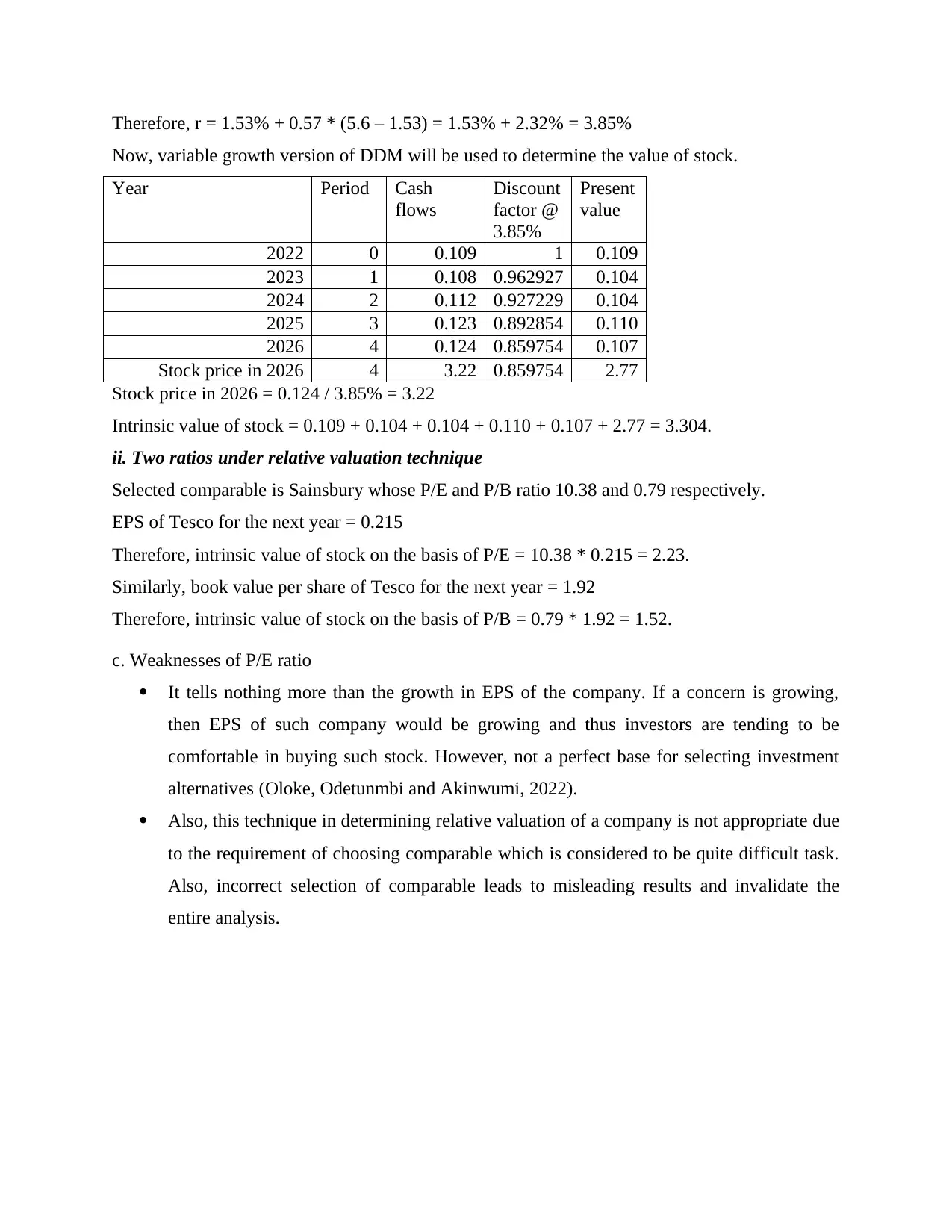
Therefore, r = 1.53% + 0.57 * (5.6 – 1.53) = 1.53% + 2.32% = 3.85%
Now, variable growth version of DDM will be used to determine the value of stock.
Year Period Cash
flows
Discount
factor @
3.85%
Present
value
2022 0 0.109 1 0.109
2023 1 0.108 0.962927 0.104
2024 2 0.112 0.927229 0.104
2025 3 0.123 0.892854 0.110
2026 4 0.124 0.859754 0.107
Stock price in 2026 4 3.22 0.859754 2.77
Stock price in 2026 = 0.124 / 3.85% = 3.22
Intrinsic value of stock = 0.109 + 0.104 + 0.104 + 0.110 + 0.107 + 2.77 = 3.304.
ii. Two ratios under relative valuation technique
Selected comparable is Sainsbury whose P/E and P/B ratio 10.38 and 0.79 respectively.
EPS of Tesco for the next year = 0.215
Therefore, intrinsic value of stock on the basis of P/E = 10.38 * 0.215 = 2.23.
Similarly, book value per share of Tesco for the next year = 1.92
Therefore, intrinsic value of stock on the basis of P/B = 0.79 * 1.92 = 1.52.
c. Weaknesses of P/E ratio
It tells nothing more than the growth in EPS of the company. If a concern is growing,
then EPS of such company would be growing and thus investors are tending to be
comfortable in buying such stock. However, not a perfect base for selecting investment
alternatives (Oloke, Odetunmbi and Akinwumi, 2022).
Also, this technique in determining relative valuation of a company is not appropriate due
to the requirement of choosing comparable which is considered to be quite difficult task.
Also, incorrect selection of comparable leads to misleading results and invalidate the
entire analysis.
Now, variable growth version of DDM will be used to determine the value of stock.
Year Period Cash
flows
Discount
factor @
3.85%
Present
value
2022 0 0.109 1 0.109
2023 1 0.108 0.962927 0.104
2024 2 0.112 0.927229 0.104
2025 3 0.123 0.892854 0.110
2026 4 0.124 0.859754 0.107
Stock price in 2026 4 3.22 0.859754 2.77
Stock price in 2026 = 0.124 / 3.85% = 3.22
Intrinsic value of stock = 0.109 + 0.104 + 0.104 + 0.110 + 0.107 + 2.77 = 3.304.
ii. Two ratios under relative valuation technique
Selected comparable is Sainsbury whose P/E and P/B ratio 10.38 and 0.79 respectively.
EPS of Tesco for the next year = 0.215
Therefore, intrinsic value of stock on the basis of P/E = 10.38 * 0.215 = 2.23.
Similarly, book value per share of Tesco for the next year = 1.92
Therefore, intrinsic value of stock on the basis of P/B = 0.79 * 1.92 = 1.52.
c. Weaknesses of P/E ratio
It tells nothing more than the growth in EPS of the company. If a concern is growing,
then EPS of such company would be growing and thus investors are tending to be
comfortable in buying such stock. However, not a perfect base for selecting investment
alternatives (Oloke, Odetunmbi and Akinwumi, 2022).
Also, this technique in determining relative valuation of a company is not appropriate due
to the requirement of choosing comparable which is considered to be quite difficult task.
Also, incorrect selection of comparable leads to misleading results and invalidate the
entire analysis.
Paraphrase This Document
Need a fresh take? Get an instant paraphrase of this document with our AI Paraphraser


REFERENCES
Books and Journals
De Bortoli, D., and et.al., 2019. Personality traits and investor profile analysis: A behavioral
finance study. PloS one. 14(3). p.e0214062.
Hawley, J. P. and Lukomnik, J., 2018. The third, system stage of corporate governance: Why
institutional investors need to move beyond modern portfolio theory. System Stage of
Corporate Governance: Why Institutional Investors Need to Move Beyond Modern
Portfolio Theory (February 21, 2018).
Malandri, L., and et.al., 2018. Public mood–driven asset allocation: The importance of financial
sentiment in portfolio management. Cognitive Computation. 10(6). pp.1167-1176.
Obeidat, S., and et.al., 2018. Adaptive portfolio asset allocation optimization with deep
learning. International Journal on Advances in Intelligent Systems. 11(1). pp.25-34.
Rodríguez, Y. E., Gómez, J. M. and Contreras, J., 2021. Diversified behavioral portfolio as an
alternative to Modern Portfolio Theory. The North American Journal of Economics and
Finance. 58. p.101508.
Oloke, O. C., Odetunmbi, O. A. and Akinwumi, S. A., 2022, March. An examination of the level
of engagement of modern portfolio techniques for portfolio management by real estate
firms in Lagos State, Nigeria. In IOP Conference Series: Earth and Environmental
Science (Vol. 993, No. 1, p. 012005). IOP Publishing.
Bhatnagar, C. S., Arjoon, V. and Ramlakhan, P., 2019. The Diversified Economy: Possibilities
from Modern Portfolio Management. In Development, Political, and Economic
Difficulties in the Caribbean (pp. 13-36). Palgrave Macmillan, Cham.
Rustagi, R. P., 2021. Investment Analysis & Portfolio Management. Sultan Chand & Sons.
Rivera-Castro, R., Pilyugina, P. and Burnaev, E., 2019, November. Topological data analysis for
portfolio management of cryptocurrencies. In 2019 International Conference on Data
Mining Workshops (ICDMW) (pp. 238-243). IEEE.
Singh, S. and Yadav, S. S., 2021. Security Analysis and Portfolio Management: A Primer.
Springer Nature.
Huy, L. P., 2018. Applying principal component analysis to cryptocurrency portfolio
management (Doctoral dissertation, International University-HCMC).
Periwal, D., 2018. TLP for Security Analysis and Portfolio Management 2017-2018.
Books and Journals
De Bortoli, D., and et.al., 2019. Personality traits and investor profile analysis: A behavioral
finance study. PloS one. 14(3). p.e0214062.
Hawley, J. P. and Lukomnik, J., 2018. The third, system stage of corporate governance: Why
institutional investors need to move beyond modern portfolio theory. System Stage of
Corporate Governance: Why Institutional Investors Need to Move Beyond Modern
Portfolio Theory (February 21, 2018).
Malandri, L., and et.al., 2018. Public mood–driven asset allocation: The importance of financial
sentiment in portfolio management. Cognitive Computation. 10(6). pp.1167-1176.
Obeidat, S., and et.al., 2018. Adaptive portfolio asset allocation optimization with deep
learning. International Journal on Advances in Intelligent Systems. 11(1). pp.25-34.
Rodríguez, Y. E., Gómez, J. M. and Contreras, J., 2021. Diversified behavioral portfolio as an
alternative to Modern Portfolio Theory. The North American Journal of Economics and
Finance. 58. p.101508.
Oloke, O. C., Odetunmbi, O. A. and Akinwumi, S. A., 2022, March. An examination of the level
of engagement of modern portfolio techniques for portfolio management by real estate
firms in Lagos State, Nigeria. In IOP Conference Series: Earth and Environmental
Science (Vol. 993, No. 1, p. 012005). IOP Publishing.
Bhatnagar, C. S., Arjoon, V. and Ramlakhan, P., 2019. The Diversified Economy: Possibilities
from Modern Portfolio Management. In Development, Political, and Economic
Difficulties in the Caribbean (pp. 13-36). Palgrave Macmillan, Cham.
Rustagi, R. P., 2021. Investment Analysis & Portfolio Management. Sultan Chand & Sons.
Rivera-Castro, R., Pilyugina, P. and Burnaev, E., 2019, November. Topological data analysis for
portfolio management of cryptocurrencies. In 2019 International Conference on Data
Mining Workshops (ICDMW) (pp. 238-243). IEEE.
Singh, S. and Yadav, S. S., 2021. Security Analysis and Portfolio Management: A Primer.
Springer Nature.
Huy, L. P., 2018. Applying principal component analysis to cryptocurrency portfolio
management (Doctoral dissertation, International University-HCMC).
Periwal, D., 2018. TLP for Security Analysis and Portfolio Management 2017-2018.
⊘ This is a preview!⊘
Do you want full access?
Subscribe today to unlock all pages.

Trusted by 1+ million students worldwide
1 out of 13
Related Documents
Your All-in-One AI-Powered Toolkit for Academic Success.
+13062052269
info@desklib.com
Available 24*7 on WhatsApp / Email
![[object Object]](/_next/static/media/star-bottom.7253800d.svg)
Unlock your academic potential
Copyright © 2020–2025 A2Z Services. All Rights Reserved. Developed and managed by ZUCOL.





